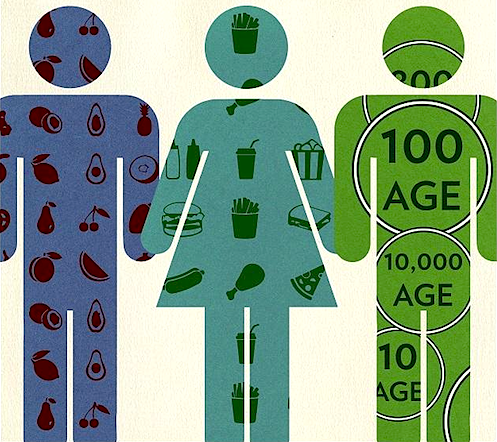|

CLICK ON weeks 0 - 40 and follow along every 2 weeks of fetal development
|
||||||||||||||||||||||||||||
|
Developmental Biology - Cancer and Diet Increasing Links Between Processed Food & Cancer AGEs are proteins and lipids (fats) that go through a chemical alteration called glycation when they are exposed to sugars — a process that occurs naturally in the body. However, processed foods and foods cooked at high temperatures are extremely high in AGEs, which can lead to their dangerous overabundance in the body. "The study of AGEs in cancer is just starting to get traction. The presence of AGEs has been known for at least 100 years, but AGE research has been challenging. In order to determine how they work, their mechanism of action, researchers first have to determine AGE's role in various diseases." AGEs Are In Nearly Every Chronic Disease In Some Way. Turner and collaborators want the public to make better food choices. In this regard, they employ a new tool to help advance the study of AGEs. The AGE reader is a noninvasive device that rests on the forearm for just 12 seconds, using light at specific wavelengths to excite AGE autofluorescence under human skin. The more AGEs in the skin, the higher the skin glows. As a link between AGE and breast cancer has been shown, the ultimate goal is to test all Hollings Cancer Center patients at each visit, if they agree. This will provide a huge amount of data about a link between AGE and a wide variety of cancers. Research is also being conducted on reversing these detrimental effects. "In our prostate cancer models, we see that physical activity counteracts prostate cancer progression in mice fed a high-AGE diet. This may be occurring due to a reduction in AGEs and changes in the immune system. We need to know more." Turner hopes educating people about AGEs, will help them make informed lifestyle decisions and lower their risks for chronic diseases. The top three things a person can do: (1) Learn what AGEs are (2) Avoid processed foods (3) Avoid high-heat cooking including: frying, grilling and broiling Abstract Advanced glycation end-products (AGEs) are implicated in the pathogenesis of several chronic diseases including cancer. AGEs are produced endogenously but can also be consumed from foods. AGE formation in food is accelerated during cooking at high temperatures. Certain high fat or highly processed foods have high AGE values. The objective of the study was to assign and quantify N?-carboxymethyl-lysine (CML)-AGE content in food and investigate the association between dietary AGE intake and breast cancer risk in the Prostate, Lung, Colorectal and Ovarian Cancer Screening Trial (PLCO). The study included women enrolled in the intervention arm who were cancer-free at baseline and completed a baseline questionnaire and food frequency questionnaire (DQX). CML-AGE values were assigned and quantified to foods in the DQX using a published AGE database. Cox proportional hazards models were used to estimate the hazard ratios (HRs) and 95% CIs of breast cancer among all women, and stratified by race/ethnicity, invasiveness of disease, and hormone receptor status. After a median 11.5 years of follow-up, 1,592 women were diagnosed with breast cancer. Higher CML-AGE intake was associated with increased risk of breast cancer among all women (HRQ5 VS Q1:1.30, 95% CI: 1.04-1.62; P-trend: 0.04) and in non-Hispanic white women (HRT3 VS T1: 1.21, 95% CI: 1.02-1.44). Increased CML-AGE intake was associated with increased risk of in situ (HRT3 VS T1: 1.49, 95% CI: 1.11-2.01) and hormone receptor positive (HRT3 VS T1: 1.24, 95% CI: 1.01-1.53) breast cancers. In conclusion, high intake of dietary AGE may contribute to increased breast cancer. Authors Omonefe O Omofuma, David P. Turner, Lindsay L Peterson, Anwar T Merchant, Jiajia Zhang and Susan E Steck. Acknowledgements This research was supported by the National Science Foundation (1250104, 1351692) and the National Institutes of Health (1U18EB029353-01, R21EY028397A). About MUSC Founded in 1824 in Charleston, The Medical University of South Carolina is the oldest medical school in the South. Today, MUSC continues the tradition of excellence in education, research, and patient care. MUSC educates and trains more than 3,000 students and residents, and has nearly 13,000 employees, including approximately 1,500 faculty members. As the largest non-federal employer in Charleston, the university and its affiliates have collective annual budgets in excess of $2.2 billion. MUSC operates a 700-bed medical center, which includes a nationally recognized Children's Hospital, the Ashley River Tower (cardiovascular, digestive disease, and surgical oncology), Hollings Cancer Center (a National Cancer Institute-designated center) Level I Trauma Center, and Institute of Psychiatry. For more information on academic programs or clinical services, visit musc.edu. For more information on hospital patient services, visit muschealth.org. About Hollings Cancer Center The Hollings Cancer Center at the Medical University of South Carolina is a National Cancer Institute-designated cancer center and the largest academic-based cancer research program in South Carolina. The cancer center comprises more than 100 faculty cancer scientists and 20 academic departments. It has an annual research funding portfolio of more than $40 million and a dedication to reducing the cancer burden in South Carolina. Hollings offers state-of-the-art diagnostic capabilities, therapies and surgical techniques within multidisciplinary clinics that include surgeons, medical oncologists, radiation therapists, radiologists, pathologists, psychologists and other specialists equipped for the full range of cancer care, including more than 200 clinical trials. For more information, visit http://www.hollingscancercenter.org Return to top of page.
|
| Jun 24  AGE accumulation is natural and unavoidable as it reflects the breakdown of nutrients, sugars and fats. Its levels increase, however, with eating processed foods high in sugar and fat. Cooking techniques like grilling, searing and frying, also increase AGE formation. Illustration by Emma Vought, Medical University of South Carolina
| |||||||||||||||||||||||||||

